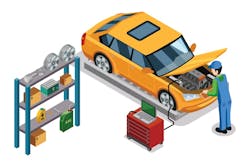Tommy Nickelson has been bitten before, and he has no intention of letting it happen again.
Nickelson, the owner of Advanced Auto Repair in Denton, Texas, has learned that even the most experienced, savvy technician can’t always diagnose every problem that results in a check engine light. That’s why Nickelson is now such an advocate for consistent, thorough use of diagnostics tools―despite the occasional challenges that the tools can present.
“I don’t want to guess with my customer’s wallet,” says Nickelson, who has owned his Texas shop since 2000. “I want to be able to prove that there’s something wrong and go from there.”
Diagnostics have changed immensely since the days of the old “red brick” with the yes/no buttons on it. That’s why Nickelson has his employees go through more than 100 hours of training each year, much of it devoted to accurately diagnosing and calibrating today’s complex vehicle technology.
These days, Nickelson notes, “you’ve got to be able to do reprogramming. I don’t care how many good parts you throw at bad software, bad software always wins. So, you’ve got to fix the software, which may or may not require a tune-up.”
But, if shop operators don’t stay on top of the latest in diagnostics, it’s nearly impossible to address every need for today’s evolving vehicles, Nickelson says.
Ratchet+Wrench spoke with a pair of shop operators to get their tips for handling the challenges that diagnostics can pose.
Communicate Clearly with Customers.
Most issues shops encounter regarding diagnostics stem from poor communication, says John Eppstein, owner of John’s Automotive Care in San Diego.
“A lot of shops get intimidated by the customer,” notes Eppstein, who serves on multiple boards, including the Automotive Service Councils of California (ASCCA). “A lot of shops don’t hold their ground and charge what they should.”
While diagnostic time made up just 25 percent of the full vehicle repair process years ago, that figure is closer to 75 percent today, Eppstein says. That’s a fact that customers need to have explained to them so they understand why they’re being charged for that diagnostics time.
It helps to explain to customers that scanning is a key step in the repair process that can help a shop diagnose the main issue affecting a vehicle. Repair facilities should explain to clients that they’re simply being careful, so they don’t end up utilizing the wrong parts for fixing a check engine light, for example.
While today’s repair shops rarely charge more than a couple hundred dollars to scan, at John’s Automotive Care, Eppstein’s staff charges an hour’s time to pull codes and run basic testing (typically, most vehicle issues can be discovered within that timeframe) and then formulates a complete repair plan from there.
“Then,” Eppstein says, “we come up with an answer that will get us in the ballpark as far as what we need to charge.”
Consider Future Opportunities.
These days, there’s no excuse for failing to thoroughly research possible scan tool purchases. In fact, scan tools can be one way to tap into a new market. For example, you may want to research how many of a certain vehicle make are in your area.
“You can pay a list company to tell you how many of those vehicles are within a 10-mile range of your shop,” Nickelson says. “And, knowing how many are in your database, you kind of have an idea: ‘Am I working on 4 percent of the European vehicles in my market? I know I can bump that number to 8-12 percent, and that’ll pay for my scan tool. And I’ll get new customers out of the deal.’”
Taking research a step further, Nickelson suggests a comprehensive study of the vehicle owners in your area before buying a scan tool. After all, it doesn’t pay to “tool up” for vehicles that will rarely ever visit your shop.
“We jumped into the European market after we found out what was in our area,” adds Nickelson, whose shop brings in $2.7 million in annual revenue. “We were working on about 2 percent of the [area’s] European vehicles, and we’re up to 12 percent now.
“It has really made a huge change in our numbers. And having the right scan tool and support makes a huge difference in trying to take care of that type of clientele.”
Consult with Colleagues.
Scan tools can be a significant investment, which is why it’s imperative your shop purchases the right ones for your vehicle mix. Before investing a few thousand dollars in diagnostic equipment, Eppstein calls upon his friends and colleagues in organizations like the ASCCA to hear their reviews. He can do that through a phone call, or a simple mass email.
Not only are colleagues eager to respond to Eppstein’s calls for assistance, they occasionally even allow his staff to borrow equipment, or visit their facilities to see those diagnostic products in action.
“When you start looking for equipment, reach out to your other shop owners―people that have used the equipment,” he says. “The biggest thing on purchasing diagnostic equipment is making sure that it’s actually used. That’s something I’ve seen a lot of: You’ll go out, spend $3,000 or $4,000 on a piece of equipment and you don’t have anybody [on staff] … that wants to take the time to use it.
“Now you’ve got a $3,000 or $4,000 paperweight that’s not making you any money.”
Other suggested steps to take before buying a diagnostics tool include: comparing pricing for the technology’s annual updates; comparing warranties; analyzing potential replacement costs; and, finally, taking note of how extensive tech support will be.
Get Sufficient Training.
With the countless codes that diagnostics can read, shop operators are liable to experience vehicle issues they’ve never encountered before. As a result, they shouldn’t hesitate to lean on industry experts after purchasing new diagnostic equipment, Nickelson says.
First, he makes sure to get his employees hands-on training, some of which provides shop workers with at least three hours in which they can closely familiarize themselves with a new product, under the tutelage of an instructor who, ideally, can relate to what’s required to make modern diagnostic procedures.
Nickelson has also received stellar tech support when calling scan tool companies, and he says that industry experts at companies like Identifix and iATN are “excellent resources” to turn to with diagnostic-related inquiries.
Diagnostics can provide shop operators with true peace of mind, assuming their staff thoroughly studies how to use the related equipment properly, with the aid of training and a review of proper procedures.
“You can’t learn all this stuff on your own,” Nickelson says. “And if you can learn from somebody else’s mistake, it’s [ideal]. … It’s been my experience that when you shortcut a step, or you don’t do the diagnostic properly, it’s always going to turn around and bite you in the rear.”

